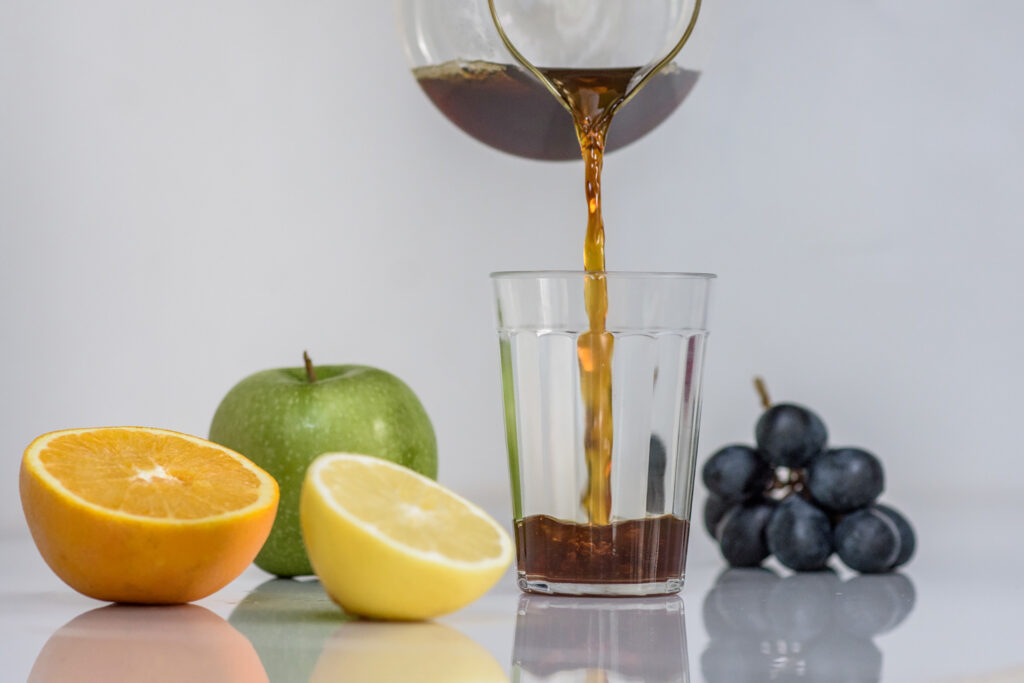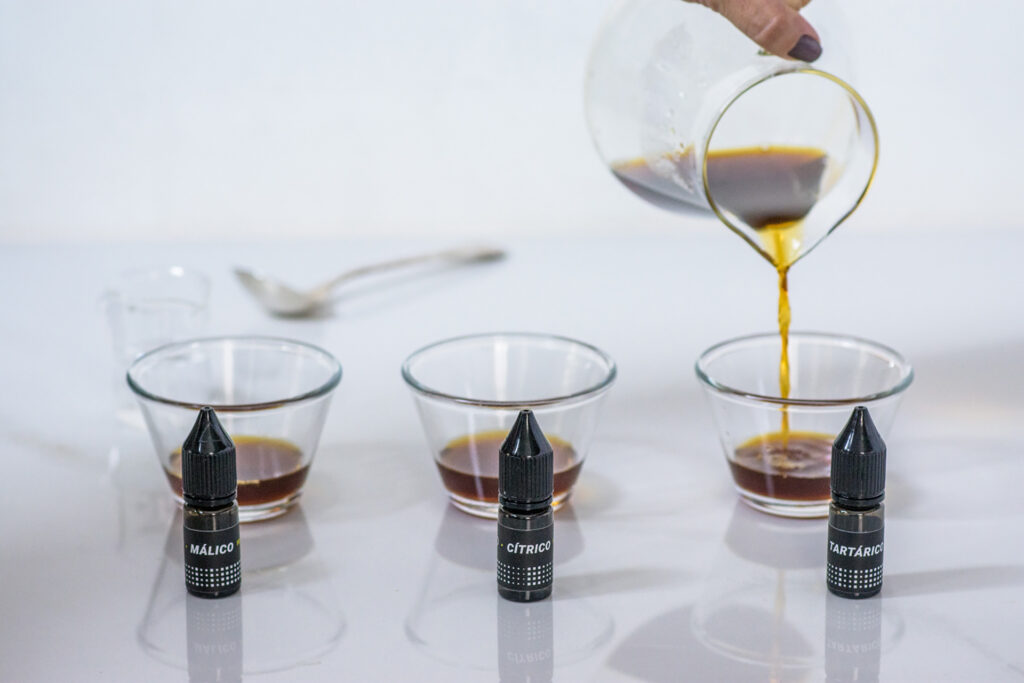Acidity in coffee can be a confusing topic. Many people—perhaps especially those who are less familiar with specialty coffee—might immediately think of stomach acidity when they hear the term. It’s only natural, then, to relate the notion of “acidity” to how drinking coffee can sometimes make them feel. If I drink too much coffee first thing in the morning on an empty stomach, aren’t I experiencing acidity?
When coffee professionals refer to acidity, they are talking about sensory traits. But even still, it’s a commonly used—and commonly misunderstood—term up and down the coffee industry, and it begs the much bigger question: What actually is acidity in coffee? How does it impact flavor?
Fortunately, we have access to experts. One such flavor expert is Veronica Belchior, a biologist with an MSc in Ecology, a Ph.D. in Food Science and currently working on her postdoctoral degree in Food Science. She is also a Q-grader and has been working with coffee for 14 years, starting as a barista, then quality manager for a coffee exporter, when she also became part of The Coffee Sensorium Project. Today she has her own company offering courses and consultancy in sensory analysis and chemistry applied to cupping, roasting, and extraction, and she also works for an export company, Cocolo Coffee Export.
Veronica Belchior and I spoke about all matters of acidity, from titratable acidity to what acids are present in our coffee and how they can impact coffee aroma and flavor—not only in the form of sourness but integral sensory attributes. This incredibly interesting conversation will change the way you think about acidity in coffee, and I hope will help us all appreciate and deepen our knowledge when it comes to this little-understood term.

Thanks, Veronica, for taking the time to talking to us about acidity in coffee. You teach a course on the subject, right? How did that come about?
Yes. I teach academic-focused courses on coffee chemistry. The acidity course came from the need to better understand how its perception (by coffee drinkers) happens and how some parameters can affect it. Water pH and temperature can change the perception of acidity as we taste coffee. Titratable acidity is a measure that is directly related to the perception of acidity and research shows that the higher the coffee TDS*, the higher its titratable acidity. There are ways to better explore the acidity that we perceive in coffee, besides just knowing how to tell apart a citric or malic acidity cup, so to speak.
*TDS = Total Dissolved Solubles (essentially coffee solubles that have dissolved and have made it into your cup of coffee)
Can you explain what is the difference between pH and titratable acidity?
pH is the quantitative measure of the acidity of aqueous or other liquid solutions. It measures the concentration of H+ ions in the solution, that is, the more H+ ions, the lower the pH. Acids have a behavior in water that is to release these H+ ions. However, the pH of the water influences, as there is another measure, the pKa, related to the strength of the acids. Weak acids have low pKa and have greater difficulty in donating H+ ions. For example, when the pKa of an acid is equal to the pH of the solution, 50% of that acid will donate H+ ions and the other 50% will remain as an intact molecule. When the pKa value of the acid is greater than the pH of the solution, the less H+ it will donate to the solution. And, pKa values lower than the pH of the solution result in more donation of H+ ions to the solution, decreasing the pH. Therefore, if the pH of the solution changes, the balance of molecules that will be whole or donating H+ also changes.

Ok, but what does it have to do with coffee?
[Belchior laughes] I am getting there. The entire molecule can contribute towards building aroma and flavors, and this of course changes a coffee’s sensory profile.
On the other hand, the titratable acidity measures the total concentration of acids present in the beverage, either as a whole molecule or by donating H+. This measure, by adding up all the acid molecules, is directly related to the acidity that we perceive. Therefore, the higher the titratable acidity, the greater the perception of acidity in coffee.
What have academic studies shown so far regarding acidity in coffee?
Many studies lay out the concentration of different acids in coffee according to the maturation, process and roasting phases. Others correlate titratable acidity with TDS and perceived acidity. We are well aware of the acids present in coffee, their origin and their behavior in water. We know the impact of pH, temperature and the interaction between molecules on the sensory profile. What remains inconclusive is how chlorogenic acids can have a positive impact, as it is known that their derivatives contribute with metallic, bitter, and astringent notes.

So, you are saying that phases like coffee ripening, post-harvesting methods, and roasting processes end up modulating the perceived acidity in our cup of coffee?
Yes, all these phases modulate the acidity in coffee. The maturation phase, for example, is essential for the production of carboxylic acids and degradation of chlorogenic acids. However, super ripe coffees will have less acidity than coffees from previous stages. The post-harvest phase is another source of carboxylic acid production. In that sense, fermentation is a phase that produces many of these acids, influencing the sensory profile. Roasting represents another phase of modulation of the acids present in coffee. High temperatures and prolonged roast times degrade carboxylic acids. Therefore, very dark or very slow roasting tend to produce coffees with less perceived acidity.
You mentioned carboxylic acids, what are the types of acids present in our coffee drink and what is their impact on flavor notes?
There are three “classes” of acids in coffee: carboxylic acids, chlorogenic acids, and phosphoric acid, which is inorganic while the others are organic. Among the carboxylic acids, about 38 different molecules are found in coffee. The most famous are citric, malic, acetic, lactic, pyruvic, among others. They are considered the main responsible for salivation in the perception of acidity. However, different acids have different sensory identities; and many of them are volatile, which makes them contribute to the perception of aromas and flavors as well. Acetic acid is very volatile and is associated with vinegary notes in coffee, pyruvic acid with burnt caramel notes. Most acids cause a lot of salivation without having a contributing aroma. According to Yeager et al. (2021) high concentrations of malic, citric, and lactic acids increase the perception of citrus and herbaceous notes in coffee, and coffee with low concentration of acids are perceived as nuttier.
As for chlorogenic acids, more than 40 different molecules are recognized in coffee. They are associated with the perception of bitterness, metallic notes, and astringency, especially because of their derivatives during roasting, which can be quinic acid, lactones, and phenylidanes. However, Yeager et al. (2021) discuss that some works show chlorogenic acids related to the greater perception of some aromas in coffee—but still inconclusively.
Phosphoric acid is the inorganic acid in coffee. Being inorganic, it is a strong acid and meaning more phosphoric acid in the beverage will further decrease the pH, influencing the balance of whole molecules or donating H+. This can impact the identity of the perception of acidity or even aromas and flavors.

What about water? How can water alkalinity impact the perception of acidity?
Water alkalinity affects the perception of acidity. According to the SCA, the alkalinity of the water must be between 40 to 75ppm CaCO3. Much below this range, water pH can drop a lot and it becomes very acidic, causing equipment corrosion. In contrast, very high alkalinity values buffer acids. Buffering makes us not perceive the acidity as it would be. Therefore, more than pH, water alkalinity has a significant impact on the sensory profile.
Can you brew coffee at home in a way that controls its acidity?
Acids are the first compounds to be extracted—they are very soluble. To soften the acidity, you can extract more of the other compounds—doing so will increase the TDS but the final cup itself will likely have a better balance.

How does the market today perceive acidity?
This question is a little more challenging to answer. In Brazil, people are getting more familiar with fermented, higher acidic coffees. However, there is this niche of people who prefer sweeter, “safer” coffees to acidic ones. I think this topic relates directly to the work of Batali et al. (2020), in which they propose a coffee brewing control framework that is more comprehensive in relation to TDS, extraction yield and consumption preferences. I believe that with a detailed framework for each type of beverage/sensory notes, we will find an audience for all tastes, from intense acidity to tea notes to chocolatey, round coffees.
Thank you!
Juliana Ganan is a Brazilian coffee professional and journalist. Read more Juliana Ganan on Sprudge.
Photos by Lucas Hallel
